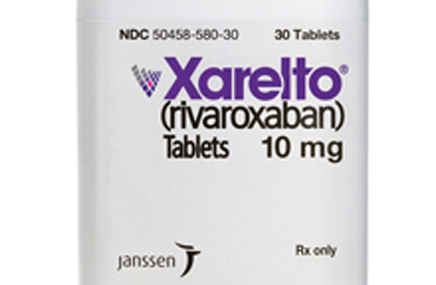This could be a big year for Bristol-Myers Squibb and Pfizer. Their oral blood thinner, which has compelling data and a best-case label in Europe, could see US approval by March. But the other two warfarin replacements will continue to play important roles. Noah Pines sets the scene and provides an update on the CV pipeline
To see our chart of the Top 50 Cardiovascular Products of 2012 (including revenues and media spend), download the PDF of this story.
Eliquis (apixaban) is coming to the US and is likely to be a category-dominator, mainly due to an ancient Greek philosopher. Despite approval delays, the factor Xa inhibitor oral anticoagulant (OAC), being developed by Pfizer and Bristol-Myers Squibb, received approval from the FDA on Dec. 28, unleashing the third in the category behind Boehringer Ingelheim’s Pradaxa (dabigatran, a direct thrombin inhibitor) and Bayer’s/Johnson & Johnson’s Xarelto (rivaroxaban, also a factor Xa inhibitor) in the burgeoning clot-prevention market.
Eliquis won European marketing approval in November to prevent stroke in patients with non-valvular atrial fibrillation (NVAF), with its label besting the anticoagulant category grandfather, warfarin, in both efficacy and bleeding rates. It had gained overseas approval earlier for preventing clots in certain surgery patients.
According to inThought, a unit of Source Healthcare Analytics, Eliquis is expected to be the preferred agent. One main reason is its massive 18,000-patient Phase III study, ARISTOTLE. While Eliquis demonstrated middle-of-the-pack efficacy, it showed a statistically significant improvement in reducing overall mortality, an important secondary endpoint that neither Xarelto nor Pradaxa achieved in their respective studies.
“It is the mortality data,” noted inThought research director Ben Weintraub, PhD, in describing why he thinks apixaban will have an edge. “The [other OACs] have not proven it yet.”
The reason why mortality benefit reaches statistical significance only with apixaban “has more to do with the sample size (ARISTOTLE being the largest of the three trials in NVAF) rather than some unique magical properties,” notes Sanjay Kaul, MD, an attending cardiologist at the Cedars-Sinai Medical Center in Los Angeles and a professor of medicine at UCLA’s Geffen School of Medicine.
ARISTOTLE spotlighted Eliquis advantages in two other areas. It decreased major bleeding by 31% compared to warfarin, topping both Xarelto and Pradaxa. Further, Eliquis’ reduction in major bleeding was statistically superior to warfarin, a result that only low-dose Pradaxa was able to achieve, while Xarelto merely achieved equivalence to warfarin on major bleeds.
Pradaxa seems to have dodged one bullet related to bleeding risk. In November, after a safety review, the FDA ruled that Pradaxa’s bleeding rates are no higher than those of warfarin. Nevertheless, BI is developing a specific antidote to its blood-thinning effects, and one just entered Phase II testing.
Despite Eliquis’s likely dominance of the category, Weintraub envisions a category that can accommodate several blockbusters, and thus that Xarelto and Pradaxa will still have important roles due to the diversity of indications. “Cardiology is complicated,” the analyst says. “All of them have a significant place.”
“The medical community will sort out which patients are best treated with which drug…in order to improve their patients’ outcomes” says Randall Zusman, MD, associate professor of medicine at Harvard Medical School and director of the division of hypertension at Mass General Hospital’s Institute for Heart, Vascular and Stroke Care.
Drugmakers have been talking up the differences. Take Pradaxa, which has enjoyed first-to-market status in the OAC category. BI spent $111.6 million on measured media for Pradaxa last year (see chart, right) and touts what it says is its unique indication for NVAF.
“Reducing the risk of ischemic stroke is the primary goal of anticoagulation in patients with NVAF, as nearly nine out of 10 atrial fibrillation-related strokes are ischemic strokes,” says Christopher Kaplan, SVP of marketing in prescription medicines at BI. “As shown in the pivotal RE-LY trial, Pradaxa…is the only treatment compared to warfarin to demonstrate superior reduction in ischemic and hemorrhagic stroke.”
Given the market dynamics, inThought expects 2019 worldwide revenues for Eliquis to be $6.9 billion as compared to $4.3 billion for Xarelto, and $4.1 billion for Pradaxa. Close on Eliquis’s heels, however, is Daiichi-Sankyo’s edoxaban, which is expected to file for approval in 2013 and is likely to also show favorable results, plus once-daily dosing (Eliquis is dosed twice daily). “Edoxaban could be a major competitor and has some dosing advantages,” says Weintraub.
Eliquis is important for both Pfizer and BMS, companies that have weathered major patent cliff events in the cardiovascular category. Despite assertive coupon and discount efforts, Pfizer statin-flagship Lipitor’s sales tumbled more than 60% in the US alone since having gone generic last November.
Revenues for generic atorvastatin, of course, have taken off, although manufacturer Ranbaxy halted production of the pills late in the year after issuing a recall due to quality issues (Watson and Mylan also make it).
Eliquis is an even more important product for BMS, which has been in search of a growth catalyst with the toppling of its top-selling anti-stroke medication, Plavix (clopidogrel). Plavix, which made $6.4 billion billion globally for BMS and co-marketer Sanofi in 2011, lost patent protection in May.
Another busy area of cardiovascular drug development is the anti-PCSK9 monoclonal antibodies, which are expected to boost LDL-cholesterol reduction beyond the frontier of current statin therapies.
These therapies are important because statins do not keep cholesterol down, or are not tolerated, in about 12 million Americans. The first-in-class entry is expected to be Sanofi/Regeneron’s SAR236553, which showed promising results in statin-treated patients in a recent Phase II study. Amgen, Merck and Pfizer also are in line with anti-PCSK9 monoclonal antibodies of their own.
According to Bernstein Research, there are potential headwinds: Whether insurers will bear the cost and patients will accept the non-oral administration could help determine whether PCSK9 agents attain broad applicability or remain niche products.
“Monoclonal antibodies…do not have a strong long-term safety track record,” adds Kaul. “It is good to see outcome studies beginning to roll out with [PCSK9] agents. Until the results of these Phase III studies are out, we should temper our enthusiasm.”
Despite the high-profile flameout of Pfizer’s torcetrapib several years ago and the demise of Roche’s dalcetrapib, the industry still is doggedly pursuing the elusive chalice of an effective approach to HDL-raising. Merck is developing anacetrapib in a large 30,000-patient outcomes study that is more than two thirds enrolled, and Lilly recently completed a Phase II study of its CETP inhibitor evacetrapib.
Again, Kaul is reserved until more data come in: “The harsh lessons learned from the ILLUMINATE (torcetrapib) and dalOUTCOMES (dalcetrapib) studies scream loudly, ‘outcomes, hard outcomes, nothing but the cold hard outcomes.’”
Merck is also expecting to file in first-half 2013 for US approval of Tredaptive, an adjunct to niacin that is marketed in Europe. Niacin products are used primarily to raise HDL cholesterol but are difficult to use due to severe flushing. Tredaptive reduces this flushing but does not fully eliminate it.
“Since other HDL raising strategies are not working, cardiologists say they need to use more niacin. While not terribly exciting scientifically, Tredaptive appears to answer that need,” states inThought’s Weintraub.
And in the orphan drug category of homozygous familial hypercholesterolemia, Isis and Sanofi are developing Kynamro (mipomersen). According to Weintraub, “The approach is very interesting, but the safety profile means that it may not be used broadly. But for those affected by familial hypercholesterolemia, it may be worth the risk.”

CLINICAL CORNER
Big clinical trials, like Pfizer/Bristol-Myers Squibb’s 18,000-patient ARISTOTLE study, can confer data that set the tone for promotion. But recruiting patients for studies of that magnitude is no easy feat.
As Julie Ross, SVP, global strategic services for the clinical research organization (CRO) PharmaNet/i3 tells MM&M, one of the top recruitment challenges in CV trials involves timing.
“At times patients are treated urgently before a trial can be considered,” she explains. “CV trials have very specific criteria and in a sense require a threading of a needle to find patients who require therapy but have not progressed so far in disease that they would require immediate intervention.”
Indeed, the CRO often needs to reach a smaller group—patients who haven’t responded to some of the existing therapies. And even if those treatments provide suboptimal efficacy, “the incentive for some of these illnesses is not great enough to compel patients to seek an alternative,” says Ken Getz, director of sponsored research programs, Tufts Center for the Study of Drug Development.
As industry increasingly looks to enroll trial subjects outside the US, geographic or regional disparities are becoming another big issue. “This was recently highlighted by the results of the PLATO trial [testing AstraZeneca’s Brilinta antiplatelet med], which showed treatment benefit outside US but potential harm in the US,” recalls Sanjay Kaul, MD, an attending cardiologist at the Cedars-Sinai Medical Center in Los Angeles and a professor of medicine at UCLA’s Geffen School of Medicine. “This poses a challenge for the regulatory bodies.”
The FDA recommends a minimum of 25-30% trial enrollment to come from within the US or North America, Kaul adds.
The agency is becoming more concerned with issues of trial design and conduct. Surrogate endpoints and biomarkers have gained attention, given data on lipid modifiers like Merck’s Vytorin, approved on the basis of lipid biomarkers without evidence of outcome benefit.
As Steven Nissen, MD, chairman of the department of cardiovascular medicine at the Cleveland Clinic Foundation, tells MM&M, “The trend is away from using surrogate endpoints and has been for several decades. They don’t tell you whether the drug will help people or not.”
The issue could come to a head soon. Merck’s IMPROVE-IT study (involving ezetimibe-simvastatin combination Vytorin vs. simvastatin alone) is coming due in early 2013 and is designed to show whether there’s an incremental outcomes advantage to using Zetia (ezetimibe), on top of background statin therapy. (The earlier ENHANCE trial found no advantage for Vytorin over simvastatin in slowing progress of athersclerosis.) If this trial shows no benefit, the regulatory standard could go from a biomarker-based to an outcome-based one, predicts Kaul, adding, “In my opinion, it is difficult to justify continuing with the status quo.” —Marc Iskowitz
From the January 01, 2013 Issue of MM+M - Medical Marketing and Media








